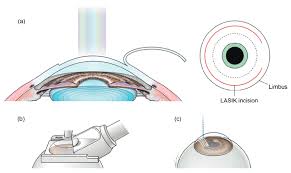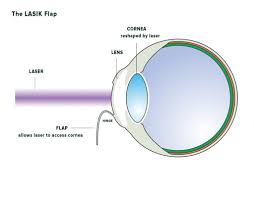Table of Contents
ToggleIf you’re struggling with vision problems, there’s a good chance you’ve considered LASIK eye surgery. Renowned for its capability to correct common refractive errors, LASIK has become a favoured option for individuals seeking liberation from glasses and contact lenses. However, if you have meibomian gland dysfunction (MGD), you might be wondering if LASIK is still an option for you.
This blog aims to address this exact concern and provide detailed insights into the relationship between MGD and LASIK, helping you make informed decisions about your eye health.
Understanding MGD
Meibomian Gland Dysfunction (MGD) is a common eye condition affecting millions of people worldwide. The meibomian glands, located in the eyelids, are responsible for secreting oils that form a crucial part of the tear film. This lipid layer inhibits the rapid evaporation of the tear’s aqueous layer, thereby ensuring stable and comfortable vision.
In MGD, these glands become blocked or dysfunctional, leading to inadequate oil secretion. This can cause instability in the tear film, resulting in dry, irritated eyes—a condition commonly referred to as dry eye syndrome.
Symptoms of MGD
- Dryness and irritation
- Burning sensation
- Redness in the eyes
- Blurry vision
- Sensitivity to light
- Eyelid inflammation
Causes of MGD
Various factors may contribute to the onset of MGD, such as:
- Age: Gland function often decreases with age.
- Hormonal Changes: Hormonal imbalances can affect gland function.
- Environmental Factors: Prolonged screen time, air conditioning, and pollution can worsen symptoms.
- Lifestyle Choices: Poor diet and lack of sleep can impact eye health.
- Genetics and pre-existing skin conditions such as rosacea can also be contributing factors.
What is LASIK?
Laser-Assisted In Situ Keratomileusis (LASIK) is a type of refractive surgery used to correct vision issues such as myopia (nearsightedness), hyperopia (farsightedness), and astigmatism. The procedure involves reshaping the cornea to enable light to focus correctly on the retina, thus improving vision.
How LASIK Works
- Preparation: After numbing the eye with anaesthetic drops, a thin flap is created on the cornea’s surface using a microkeratome or femtosecond laser.
- Reshaping: An excimer laser is then used to reshape the underlying corneal tissue, correcting the refractive error.
- Repositioning: The corneal flap is gently repositioned back without the need for stitches, where it naturally bonds back in place.
Benefits of LASIK
- Quick Procedure and Recovery
- Minimal Pain
- Significant Vision Improvement
- Reduced Dependence on Glasses or Contacts
LASIK and MGD Interaction
Given that both LASIK and MGD involve the ocular surface, it’s essential to consider their interaction carefully.
LASIK surgery can exacerbate dry eye symptoms due to temporary nerve damage in the cornea, which can impair tear production.
Since MGD already contributes to dry eye, this combination might lead to increased discomfort post-surgery.
Considerations Before LASIK
Before deciding on LASIK, it’s vital to consult with an eye care professional who can assess the severity of your MGD and overall eye health. Here are some key considerations:
1. Pre-existing Dry Eye:
Assess the severity of your dry eye symptoms and consider treatment options to stabilize the condition prior to undergoing LASIK surgery.
2. Eye Examination:
A comprehensive eye exam is crucial to evaluate the health of your cornea, tear production, and the function of your meibomian glands.
3. Lifestyle Adjustments:
Implement lifestyle changes, such as increased omega-3 intake, regular eye hygiene, and reduced screen time, to improve your overall eye health.
4. Alternative Treatments:
Explore other corrective options such as PRK (photorefractive keratectomy) that may pose less risk for individuals with dry eye conditions.
Management Strategies for MGD Pre-LASIK
If you’re determined to proceed with LASIK, managing your MGD effectively before the surgery is crucial. Here are some strategies to consider:
Warm Compresses
Applying warm compresses to your eyelids helps soften the oils and unclog the meibomian glands, promoting healthier oil secretion and improved tear film stability.
Lid Hygiene
Maintain good eyelid hygiene by gently cleansing your eyelids with a mild, non-irritating cleanser. This reduces the risk of inflammation and infection, ensuring optimal gland function.
Omega-3 Fatty Acids
Include omega-3 fatty acids in your diet through sources like fish oil supplements or flaxseed. These nutrients have anti-inflammatory properties that can support gland health.
Prescription Medications
In some cases, prescription medications like cyclosporine or corticosteroids may be recommended to address inflammation and improve gland function.
Advanced Treatments
Consider advanced treatments like LipiFlow, a thermal pulsation device designed to unclog meibomian glands and improve oil secretion.
The Role of Post-LASIK Care
Post-operative care is essential to ensure a smooth recovery process and minimize the risk of complications, especially for individuals with MGD.
Lubricating Eye Drops
Regularly utilize preservative-free lubricating eye drops to maintain eye hydration and comfort. This practice is especially crucial during the initial healing phase.
Regular Follow-ups
Schedule follow-up appointments with your eye care provider to monitor your progress and address any concerns promptly.
Avoid Rubbing Eyes
Refrain from rubbing your eyes, as it can disrupt the healing process and affect the positioning of the corneal flap.
Protect Your Eyes
Shield your eyes from excessive wind, sun, and dust by wearing sunglasses when outdoors. This helps prevent irritation and dryness.
Parting Thoughts
Ultimately, the decision to undergo LASIK while having MGD is a deeply personal matter that necessitates thorough deliberation and consultation with a qualified eye care professional. By understanding the potential risks and taking proactive measures to manage your MGD, you can increase the likelihood of a successful LASIK outcome.
Remember, your eye health is paramount. Prioritize open communication with your eye care provider, explore alternative treatment options if necessary, and commit to maintaining optimal eye hygiene and nutrition.
If you’re considering LASIK and have MGD, take the time to gather all the information and support you need to make an informed choice. Prioritize your comfort and vision, and don’t hesitate to reach out to professionals who can guide you through the process.
Your vision is worth every effort, and with the right approach, you can achieve the clarity and freedom you desire.













